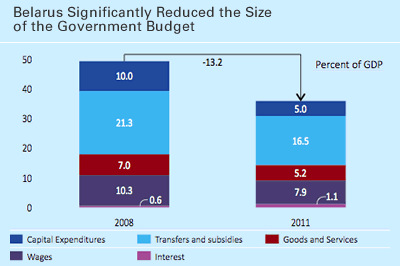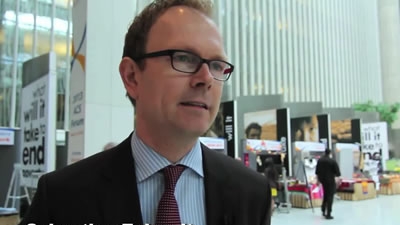![]()
This report identifies reform opportunities in Belarus to enhance the quality of key public services in a fiscally constrained environment. It analyzes macro-fiscal trends, intergovernmental fiscal relations, and public spending in the education and health sectors.
Securing Macro-Economic Stability and Fostering Growth
- Since 2008, Belarus achieved a large fiscal contraction, with revenue falling from over 50 percent of GDP in 2008 to 39 percent in 2011. Spending fell from close to 50 percent of GDP in 2008 to about 36 percent in 2011.
- This contraction relied heavily on cuts in government investments. Reduction in subsidies has been very slow. Social spending was largely protected from cuts.
- Despite moderate fiscal deficits, public debt has more than doubled since 2008, reaching 32 percent of GDP by the end of 2011, as a result of currency devaluation and banks’ recapitalization.
- With about half of the public debt maturing over the next three years, Belarus faces significant refinancing needs.
- Fiscal policy needs to remain tight to secure macro-economic stability. This implies moderation in public sector wages and pensions, rationalization of subsidies, and prevention of additional cuts to government investment.
Strengthening Incentives for Sub-national Governments
- Sub-national spending accounts for more than half of consolidated general government spending, financing key public services such as utilities, health, education and infrastructure.
- Shared national taxes contribute roughly 60 percent of sub-national revenue. Transfers from the central government make up another 35 percent. Only 5 percent comes from own-source taxes and non-tax revenue.
- Sub-national liabilities have increased to about 10 percent of GDP by the end of 2011—about double its 2007 level. Debt and guaranteed debt in three oblasts and 17 rayons exceeds 80 percent of pre-subventions revenue (the statutory limit set in the Budget Code).
- Heavy reliance on transfers from the central government together with rising sub-national liabilities discourage sub-national governments from exercising fiscal restraint and achieving efficiency gains in public spending.
- Incentives for sub-national government could be strengthened through a simplified transfer formula and containment of sub-national liabilities, especially in highly indebted sub-national governments.
Enhancing Spending Efficiency for Better Health Results
- The health system has achieved significant progress in infant and maternal health and containment of communicable diseases.
- Life expectancy, especially among men, remains low, largely due to a growing prevalence of cardio-vascular diseases, which are now the main cause of mortality.
- Public health spending is equal to 3.5 percent of GDP (2011), commensurate with Belarus’ level of income. Private spending on health care only accounts for about 1.2 percent of GDP, reflecting a high level of financial protection from health related economic risks.
- The health system still heavily relies on hospitals: 47 percent of health spending is allocated to general and specialized hospitals, and Belarusians get admitted to hospitals more often and stay hospitalized longer than citizens in other countries. This drives health care costs up, and does not translate into above-average health outcomes.
- Addressing health challenges in a fiscally-constrained environment will require comprehensive reform to introduce stronger incentives for efficiency, results-orientation and quality of care.
Enhancing Spending Efficiency for Better Education Results
- The educational system in Belarus has performed well in improving access and enrollments.
- The number of school aged children has fallen from 1.5 million in 1990 to around 1 million today. As a result, student-teacher ratios at both the primary and secondary level are among the lowest in the region, driving up per-student costs.
- At 5 percent of GDP, public spending on education is in line with the regional average, but the focus needs to be on increasing efficiency.
- Skills mismatch is a growing issue. More Belarusian firms than anywhere else in the region report that it is tough to find skilled workers, which constrains their growth.
- Addressing education challenges requires further efforts to right-size the school network, reinforced by a gradual move to per-student financing, combined with strengthened accountability for results.



